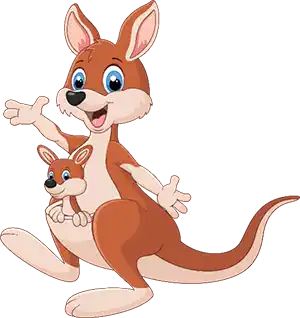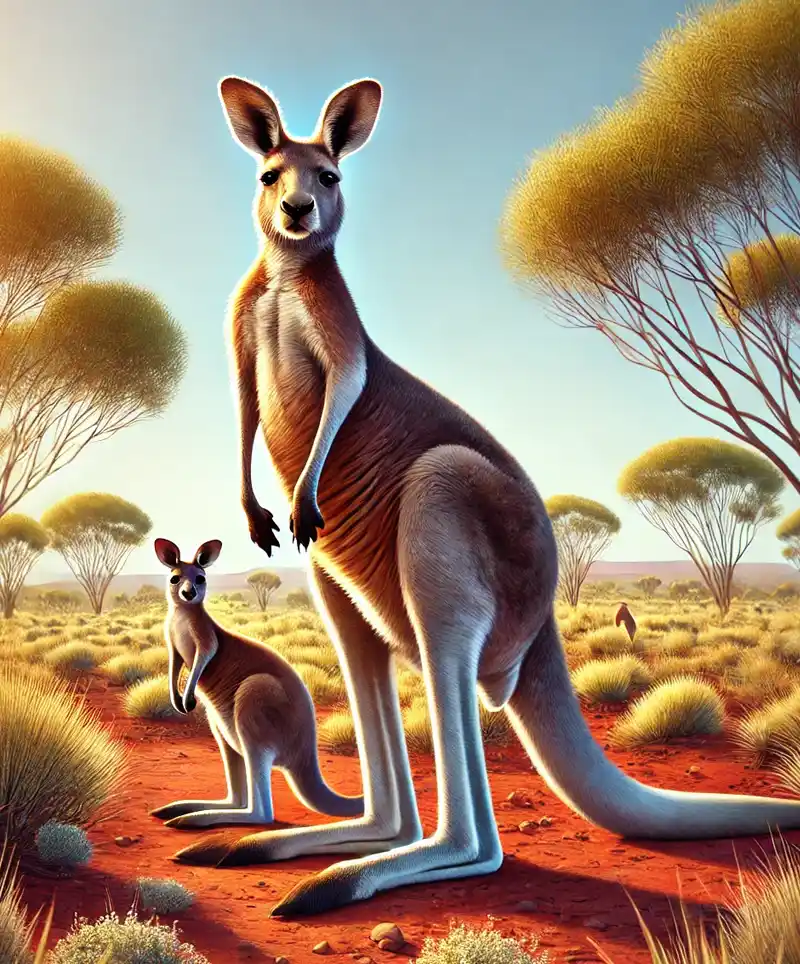Bounding Through History
Kangaroos, the iconic symbol of Australia, have been around for millions of years. In fact, these marsupials are members of the Macropodidae family, which literally means "big foot." That’s a fitting name, considering kangaroos have massive hind legs that allow them to hop like it’s a full-time job. But before you picture them bouncing around the Australian outback with abandon, let’s pause to admire the evolutionary journey that turned them into the ultimate hoppers.
Kangaroos evolved to adapt to Australia’s often harsh environment. From hopping across arid plains to munching on grasses, they’ve made themselves at home in a land filled with dangers, including humans who didn’t always appreciate the kangaroo's gymnastic prowess. And if you think kangaroos are just for show, you’d be mistaken—these creatures are a keystone species, playing a crucial role in maintaining their ecosystem by grazing on vegetation and preventing overgrowth.
The Anatomy of a Hopper
Hopping is not just a cute party trick; it’s a highly efficient way for kangaroos to cover large distances. Thanks to their powerful hind legs and long tail, they can leap up to 30 feet in a single bound and reach speeds of 35 miles per hour. The tail acts as a counterbalance and even as a third leg when they need to stand still—though standing still isn't really their style.
While those legs may make them the Michael Jordan of the animal kingdom, they do come with a quirk: kangaroos can’t walk backward. If you ever need to engage in a staring contest with a kangaroo, rest easy knowing it won't back out of the challenge. It’s full steam ahead for these bouncing athletes.
The Ultimate Parenting Hack
Kangaroos are the original trendsetters of babywearing. Their famous pouch, scientifically known as a "marsupium," is not just a fashion accessory; it's a full-on nursery on the go. Kangaroo mothers, or "does," give birth to tiny, underdeveloped joeys after a pregnancy of about 30 days. The joey, smaller than a jellybean, then climbs into the pouch to finish its development.
Once snug inside, the joey stays there for about six months, nursing and growing, while mom goes about her day, hopping from one grassy buffet to the next. The pouch is self-cleaning, and it stretches as needed, which means the joey rides in comfort like the VIP it is.
Kangaroo Boxing: More Than a Punchline
You’ve likely heard that kangaroos box, but this isn’t just for show. Males, called "boomers," engage in boxing matches to establish dominance and win over the ladies. It’s not quite the UFC, but close. Using their strong arms and legs, they spar with one another, aiming to knock the other kangaroo off balance. But here’s the twist—they often balance on their tails during these fights, making them a sort of tripod of terror. And if that doesn’t work, they’ve got razor-sharp claws to back up their bravado.
But don’t worry; kangaroos aren't picking fights with random passersby. They’re generally pretty chill, lounging in the shade and snacking on grasses, as long as no one gets in their way.
Social Hoppers
Kangaroos aren’t the solitary drifters you might think they are. In fact, they live in groups called "mobs," and it’s not just for safety in numbers. Mobs provide social structure, support, and more eyes to watch for predators like dingoes. The dominant male boomer often leads these hopping herds, though females and younger kangaroos make up the majority of the group.
 Social life for a kangaroo involves plenty of grooming, playing, and the occasional boxing match to keep things interesting. If you ever find yourself surrounded by a mob of kangaroos, just remember—they’re more likely to be curious than confrontational, especially if you brought snacks.
Social life for a kangaroo involves plenty of grooming, playing, and the occasional boxing match to keep things interesting. If you ever find yourself surrounded by a mob of kangaroos, just remember—they’re more likely to be curious than confrontational, especially if you brought snacks.
Kangaroo vs. Wallaby: What’s the Difference?
At first glance, you might think a wallaby is just a mini-kangaroo, but these two marsupials are actually quite different despite being from the same family. It’s like comparing a bicycle to a motorcycle—both are wheeled, but one’s a whole lot bigger and faster!
Size Matters: The most obvious difference between kangaroos and wallabies is their size. Kangaroos are the giants of the Macropodidae family, with some males standing over six feet tall. Wallabies, on the other hand, are more compact and can fit in the "pocket-sized marsupial" category (well, at least compared to kangaroos). Wallabies usually stand at about 2 to 3 feet in height, making them the more "approachable" cousin for a quick photo op.
Built for Different Terrains: Kangaroos and wallabies also have different leg structures suited to their environments. Kangaroos, with their long, powerful legs, are designed for wide, open spaces like Australia’s grasslands and deserts, where they can really stretch out and get those 30-foot hops in. Wallabies, however, are more nimble and compact, making them better suited for navigating dense forests and rocky terrains. They may not leap as far, but their agility allows them to dart through undergrowth with ease.
Color and Appearance: Kangaroos tend to have a more uniform grayish-brown color, which blends perfectly with the arid Australian landscape. Wallabies, on the other hand, often sport a variety of color patterns, with many species having distinct markings and brighter colors. Some even have flashy orange, red, or white fur in patches, making them the more colorful of the two. If kangaroos are the athletes of the marsupial world, wallabies are the fashionistas.
Diet Differences: While both kangaroos and wallabies are herbivores, their diets reflect their habitats. Kangaroos munch on grass like it’s going out of style, spending hours grazing on vast plains. Wallabies, being forest dwellers, have a more varied menu that includes leaves, shrubs, and fruits. They’re less picky eaters than their big cousins and will snack on whatever vegetation they can find in the forests.
The Speed and Hop Factor: Kangaroos, with their long legs and larger size, are built for speed and distance, often reaching speeds of up to 35 miles per hour and hopping long distances to conserve energy. Wallabies, being smaller and more compact, are better at short bursts of speed and quick maneuvers, making them agile in more enclosed environments. They may not set speed records, but they’re acrobatic and graceful in their own right.
The Tail of the Tape: Kangaroo tails are thick and long, providing balance during their massive jumps and serving as a handy "third leg" when they’re on the move. Wallabies also rely on their tails for balance, but since they’re not making those giant leaps across the plains, their tails are a bit shorter and not quite as beefy as the kangaroo’s.
So, while kangaroos and wallabies share a family tree, they’ve each evolved in ways that make them uniquely suited to their environments. Kangaroos are the marathon runners of the marsupial world, built for long-distance hopping and endurance, while wallabies are the sprinters, designed for quick dashes through dense forest. Both are quintessentially Australian, but they bring their own brand of marsupial charm to the table.
Now you can impress your friends with the ultimate trivia: the next time someone says, “Look at that kangaroo!” you’ll know if it’s a wallaby stealing the spotlight!
A Hoppy Relationship
Australians have a complex relationship with kangaroos. They appear on the national coat of arms and are beloved symbols of the country, but they can also be seen as pests by farmers who don’t appreciate the kangaroo’s taste for crops. The good news? Kangaroo populations are robust, with an estimated 50 million of them hopping around Australia—that’s twice the human population!
Kangaroo meat has even become a sustainable and lean alternative for those looking to reduce their carbon footprint. It’s low in fat, high in protein, and has become somewhat of a delicacy for eco-conscious foodies. Just don’t mention this to Skippy, the beloved TV kangaroo who’s surely rolling over in his pouch at the thought.
Fun Facts to Bounce Around With
-
Kangaroo Nicknames: You’ve got your boomers (males), does (females), and joeys (babies). But a group of them? That’s called a "mob." Now that’s one mob you wouldn't mind running into.
-
Gas-Free Grazers: Unlike cows, kangaroos don’t produce methane gas when they digest food. They’ve got a unique digestive system that breaks down plant matter in a way that keeps greenhouse gases to a minimum. Talk about environmentally friendly!
-
They’re Lefties: Studies have shown that kangaroos tend to favor their left hand—or paw—when eating, grooming, or grabbing onto things. They might be the only animal species outside of primates that shows such a strong preference for one hand over the other.
 How to Celebrate World Kangaroo Day
How to Celebrate World Kangaroo Day
For World Kangaroo Day, you can celebrate by learning more about these fascinating marsupials, watching some classic kangaroo-themed TV (we see you, Skippy), or donating to wildlife conservation efforts in Australia. If you’re feeling adventurous, try jumping around your backyard to see if you can match a kangaroo’s hopping skills—but don’t be surprised if your neighbors start asking questions.
You could also plan a themed dinner with kangaroo-inspired dishes—minus the kangaroo meat, of course. Instead, opt for some plant-based options and raise a toast to these amazing creatures that embody the wild spirit of Australia.
So, on World Kangaroo Day, let’s tip our hats—or tails—to the kangaroo, the bouncing, boxing, eco-friendly legend of the land Down Under!
Please Share our Content






 Social life for a kangaroo involves plenty of grooming, playing, and the occasional boxing match to keep things interesting. If you ever find yourself surrounded by a mob of kangaroos, just remember—they’re more likely to be curious than confrontational, especially if you brought snacks.
Social life for a kangaroo involves plenty of grooming, playing, and the occasional boxing match to keep things interesting. If you ever find yourself surrounded by a mob of kangaroos, just remember—they’re more likely to be curious than confrontational, especially if you brought snacks. How to Celebrate World Kangaroo Day
How to Celebrate World Kangaroo Day








 "Sláinte!" is a traditional Irish expression used as a toast, equivalent to "Cheers!" in English.
"Sláinte!" is a traditional Irish expression used as a toast, equivalent to "Cheers!" in English.